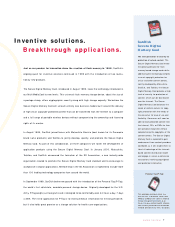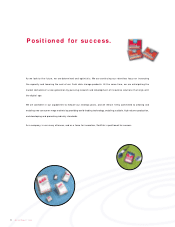SanDisk 1999 Annual Report Download - page 19
Download and view the complete annual report
Please find page 19 of the 1999 SanDisk annual report below. You can navigate through the pages in the report by either clicking on the pages listed below, or by using the keyword search tool below to find specific information within the annual report.
16 Annual Report 1999
MANAGEMENT’S DISCUSSION AND ANALYSIS
Depending on the demand for our products, we may decide to make
additional investments, which could be substantial, in assembly and
test manufacturing equipment or foundry capacity to support our
business in the future. We expect operating expenses to continue to
increase as a result of the need to hire additional personnel to support
expected growth in sales unit volumes, sales and marketing efforts
and research and development activities, including our proposed col-
laboration with Toshiba providing for the joint development of 512
megabit and 1 gigabit flash memory chips. We believe the existing
cash and cash equivalents and short-term investments will be suffi-
cient to meet our currently anticipated working capital and capital
expenditure requirements for the next twelve months.
On January 3, 2000, the USIC foundry was merged into UMC. We
previously invested $51.2 million in USIC. In exchange for our USIC
shares, we received 111 million UMC shares. These shares were val-
ued at approximately $396 million at the time of the merger,
resulting in a pretax gain of $344 million ($204 million after-tax).
All the UMC shares we received as a result of the merger are sub-
ject to trading restrictions imposed by UMC and the Taiwan Stock
Exchange. The trading restrictions will expire on one-half of the
shares six months after the date of the merger. The remaining shares
will become available for sale over a two year period beginning in
January 2002. When the shares are ultimately sold, it is likely that
we will report additional gains or losses. To the extent we can liqui-
date the UMC shares, we will plan to use such funds to support our
operations and capital expenditures.
Impact of Currency Exchange Rates
A portion of our revenues are denominated in Japanese Yen. We
enter into foreign exchange forward contracts to hedge against
changes in foreign currency exchange rates. At December 31,
1999, two forward contracts with notional amounts of $8.2 million
were outstanding. Future exchange rate fluctuations could have a
material adverse effect on our business, financial condition and
results of operations.
Impact of Recently Issued Accounting Standards
In June 1998, the Financial Accounting Standards Board issued
Statement 133, Accounting for Derivative Instruments and Hedging
Activities, which is required to be adopted in years beginning after
June 15, 2000. Because of our minimal use of derivatives, we do
not anticipate that the adoption of the new Statement will have a
significant effect on our earnings or financial position, however, we
are in the process of studying the actual impact.
Year 2000 Readiness Disclosure
Year 2000 problems are the result of common computer
programming techniques that result in systems that do not function
properly when manipulating dates later than December 31, 1999.
The issue is complex and wide-ranging. The problem may affect
transaction processing computer applications we use for account-
ing, distribution, manufacturing planning, and communications.
The problem may also affect embedded systems such as building
security systems, machine controllers and production testing equip-
ment. Year 2000 problems with these systems may affect the ability
or efficiency with which we can perform many significant functions,
including but not limited to order processing and fulfillment, material
planning, product assembly, product testing, invoicing and financial
reporting. We have not to date experienced any material impact in
any of these areas. The Year 2000 problem may also affect the com-
puter systems of our suppliers and customers, potentially disrupting
their operations. Year 2000 problems with our business partners
may impact our sources of supply and demand.
YEAR 2000 READINESS.
We conducted a Year 2000 risk management program to assess the
impact of the Year 2000 issue on us, and to coordinate remediation
activities. We completed the evaluation of out products for Year
2000 compliance in the third quarter of 1998. Our storage and con-
nectivity products are used as components in a variety of host
systems. The firmware, operating system and application software of
these host systems are designed and manufactured by others. We
make no claim with regard to the Year 2000 readiness of host sys-
tems designed by others in which products are used. In addition,
independent system designers make derivative works from out Host
Developer’s Toolkit source code product. We make no claims with
regard to the Year 2000 readiness of host firmware and operating sys-
tems designed by others that contain derivative works of the Toolkit.
The Year 2000 remediation of our transaction processing systems
was completed with the installation and testing of our new manage-
ment information system in the fourth quarter of 1998. In the
second quarter of 1999, we completed all of the primary elements
of our Year 2000 assessment and remediation program for our prin-
cipal hardware and software. Tests of software applications, which
have been identified by their vendors as Year 2000 compliant, and
several minor software upgrades were successfully completed in the
third quarter of 1999.
























